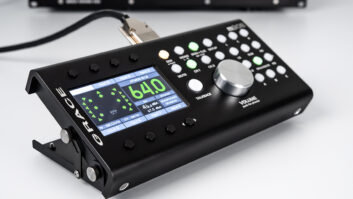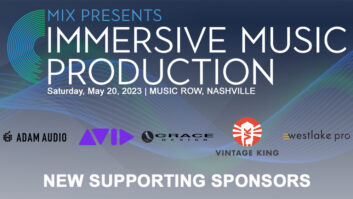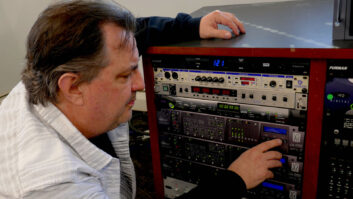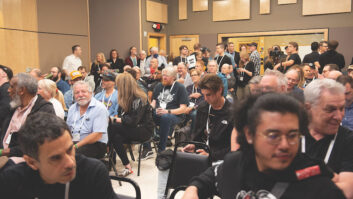To some, ADR is the dirty little secret of post-production, an insurance policy you don’t want to have to collect on. For little accidents in production-airplane hum, dolly squeaks, acts of God-you bang out the dents and polish it up, but it never quite looks the same. Not surprisingly, many of the people who’ve spent their careers in Automated Dialog Replacement tell a different story. These folks approach what they do with a sense of the possibilities, and they’re able to make things happen that don’t just fill holes in production but take it a step further.
Titanic, Fight Club, The English Patient and Star Wars: Episode I are all better films as a result of innovative and clever ADR. Who would guess that most of Titanic was looped? or that some of the most pivotal lines in The English Patient were inserted over a shot of actors saying something completely different?
My conversations with seven leading ADR mixers, supervisors and re-recording mixers [see “ADR Panel” sidebar] reveal a diversity of beliefs and practices. These practices can evolve from project to project, depending on the requirements of the film, the priorities of the director and the abilities of the actors. As in all things, attitude is essential to the success of ADR. Where one person sees an insurmountable problem, another has a technique or a bit of technology to solve it. ADR, in the end, is as big or small a part of the post-production puzzle as the supervisor and director decide it needs to be. The people who do it best know that it’s only important insofar as it serves the interests of the soundtrack overall.
ADR: WHEN AND WHERE?If ever a film was a candidate for ADR it had to be Titanic. “Titanic was a nightmare,” recalls Hugh Waddell. “While they were shooting on one side of the ship, they were building the other side. There were buzz-saws, beeps from trucks backing up, construction workers yelling at each other, wind machines, wave machines and general background voices.”
That, and a director for whom money was no object, led to the decision to loop up to 95% of the production. The result, at the mixing stage, was a choice between production and ADR on virtually every line, and for more than 75% of the material, ADR was chosen. “A lot of times you have difficulty convincing the director that it’s better than the original,” says Waddell. “People like Jim Cameron, however, have such a finely tuned ear that they know instantly when they hear something better.”
For example, “in the stateroom scenes they had huge xenon lights with big fans in them, and there was a buzz throughout,” Waddell says. The more controlled environment of an ADR stage allowed for “a very intimate, quiet ambience to enhance the scenes. Being that they were first-class state-rooms, it sounded very plush. Jim was more happy with that.”
Reality, unfortunately, is not always so simple, especially when you hear things like the reverberation of echoes the way Tom Johnson does. “It’s so complicated in terms of early reflection and things like that. There’s no digital device that I know of that can match what a real echo sounds like.”
To address this, an ADR mixer like Bob Baron or Doc Kane will place a second microphone in a corner to get a little bit more slap. This seems to work best for interiors. A larger room, like Stage B at Disney, may even have “sweet spots,” according to Kane. “If it’s a kitchen scene and something is a little bit bouncy, I just let the microphones and the room try and replicate the location sense.”
Then there are the spontaneous, unscripted moments that give character and life to production. Whether or not a director still wants those is often a matter of style. Gwen Whittle says that on Saving Private Ryan, “Speilberg wanted a very gritty, war sound to it. So the pops and clicks and smacks-the normal kinds of things that you would get rid of-he wanted to keep in.” Films like Star Wars: Episode I, on the other hand, which embrace technology, are naturals for ADR. “The big fight outside the space ship where Darth Maul falls in,” according to Whittle, “wasn’t beautiful production but certainly usable. There was a hum and a thinness to it. So, they redid it, and we have this quiet, quiet, quiet sort of space thing going on.”
The duration of the Star Wars project and George Lucas’ openness to innovation encouraged the crew to address some technical hurdles in the ADR process. “one of the things I don’t like about ADR,” says Matt Wood, “is the fact that you send it out to these studios all over the world and you get all these various sources, different rooms, different miking setups. Some might come back with DA-88s, some might even come back with quarter-inch at this point, and then it all has to get back onto your workstation.”
Wood’s mobile workstation-a Powerbook G3 with a PCI extension chassis from Magma, Audiomedia III card by Digidesign and a Miro DC30 Plus card for QuickTime movies-was a move toward consistency and accessibility. “It just gave me the ease of use of ‘I have all the takes in the machine, they’re already labeled.'” Wood could then e-mail it back over the Internet to editorial, start to cut on the stage or, as it happened, on Lucas’ private jet after a session in the Bahamas.
With everyone on the same Pro Tools playing field, even access to freshly recorded material was instantaneous. “There was no transfer time, no question about frame rate issues,” Wood says. Back at the Ranch, a Macintosh network enabled sound designer Ben Burtt, who also had his hands full with picture editing, to perform quick processing operations then send it right back to the ADR editors.
MATCHING PERFORMANCESIntegration between the various depart- ments can be critical when a director like James Cameron decides to use whatever whenever. Tom Johnson re-calls “a couple of deck scenes where he was having me put in two words from ADR, two words from production, just going back and forth really quickly, and when you put the ADR in you lose all of the production ambience.” To smooth things out, Johnson required usable production from the dialog editors to lay under the ADR and “quite a lot of fader moves.”
It also helps if the ADR meets the same parameters as the production sound. This is where the close readings of a mixer like Doc Kane can make or break it. “If I feel there’s little subtle differences, I’ll adjust a little high end here or add a little low end there,” he says. “We try and duplicate that production almost as a one-to-one.”
These things take time, but good ADR adds color to a director’s palette. The big torture scene in The English Patient-where Willem Dafoe gets his thumbs cut-is the example Mark Levinson gives: “We had to build in intensity as the scene increased. It was not necessarily true that it built that way in production. It was one of the most integrated production and ADR scenes I’ve ever worked on. Trying to integrate the shouts of desperation and pleading was something that could be done with ADR.”
There are also cases where, to the mind of an actor or director, the performance is not where it needs to be. The ADR stage becomes the place where they can, according to Waddell, add something “just slightly different from the original quality, which can bring points out of a scene that you never knew existed.” Because of the degree of technique required to match tone, pitch, emotion and sync, not all actors can do it. Waddell draws a distinction “between performers and trained actors. Performers have a big problem reproducing on the ADR stage what they can on the set because they’re used to being in front of the camera, in front of people, and when the lights come on, suddenly they become the character.”
What you do with an actor to get them back to that point can also make a big difference. “I have had actors do everything. For instance, Kate Winslet, in Titanic, when she’s lying on the raft just before Leo goes underneath the water-we had her lie on a bench for two days straight to recreate the same vocal quality.”
The result is an example of ADR that fooled even Titanic dialog editor Gwen Whittle: “I never knew it wasn’t production. All that breathing stuff, I mean it sounded cold. If they hadn’t done all the shakes in their voices and that kind of stuff, you never would have bought it for a minute.”
This is the thing people either love or hate about ADR: You put in one piece and then there’s another, and they don’t always fit, but the more pieces you find the better it works. “It’s got to be the right performance to match their eyes and their face and their body language,” says Whittle. “You can’t fix energy level. You could change the pitch if you wanted to. Energy level, that’s half of it, more than half of it. If the energy’s not there, it’s not going to work.”
Kane has a slightly different take: “I think it all comes down to pitch. Sometimes you get these actors in the morning. The shot was done at 4 a.m., and they’d been working for 12 hours. Their voice is in a whole different spot. They haven’t talked to their agents or anything. And then we start to loop, and I will listen to see. Are they lower? Are they a little bit higher? I’ll play it back, and we’ll AB against the production. once the actor hears it, he goes, ‘oh, okay. Now I know where my pitch is.'”
REAL-WORLD ACTION IN A STUDIOHow do you make an actor on a stage sound like one who’s moving? It’s a fundamental challenge for the ADR mixer. Baron thinks “people who play a musical instrument are really good, people that are physical. It’s like a dance. If you can get the motion of your body, it will sound like it.”
Kane declares, “I’m up for anything. If the director says, ‘I want this guy to walk around the parking lot 17 times and then come in,’ we’ll do it.” of course, there are limits to how much physicality you want on the stage. With too much movement, you need a boom, and “having a boom person out there gets annoying.”
To simplify the process, a performance is broken down into elements: pitch, tone, rhythm, emotion, sync. Each mixer and editor has a different idea about what’s most important, but sync is still the bottom line. As Mark Levinson puts it, “No matter how good the performance is, if it’s a sync line and it doesn’t work, it won’t go in.”
To make it work, an actor needs to stay within the rhythm established in production. on Bicentennial Man, Whittle saw how easily someone like Robin Williams is able to do just that. “His rhythm will be a little bit off, and he’ll try again. And then he’ll get it, and he can nail it, time after time after time. That’s probably why he’s a good comic; he’s got the timing thing down.”
For those who do not possess the gifts of a Robin Williams, Baron keeps “a little Roland digital sampler. I just hit this one button after the beeps and I capture it. It’s almost like a rap song. They do it four or five times, no picture, and when you feel in your heart that they got it, ‘Bam!’ you just take off and record.”
NON-SYNC REPLACEMENT LINESIn cases where the director needs to change a line in post, and sync is no longer a possibility, it falls to the ADR editor to make it work. “If you can start it on camera in some plausible way,” says Levinson, “then have it go off camera where you put in the ADR, it feels a lot more organic.” Viewers don’t really notice when an actor’s line continues over a shot of the person they’re talking to, so long as it’s not done too often.
Occasionally, a director decides to change words spoken on screen. The replacement of foul language, what’s known as TV ADR, is a bit of a write-off for most editors. Script changes to strengthen a character or change a plot, what Waddell calls “offspring dialog,” are of greater concern to a director and must therefore be handled carefully. “Rather than watching the lips,” says Waddell, “you watch the action of the head to make it seem more believable.”
A change like this can involve some serious reconstruction, as in this example from The English Patient, where director Anthony Minghella and editor Walter Murch put a redundant scene back in the film as a place to insert some new lines. Levinson explains, “Anthony remembered this shot which was wide enough that you couldn’t see exact sync on some of it, and they cut it in such a way that the first line and the last line were what was really said in the scene. And then we changed the entire text of the dialog in between. We were able to completely make it a scene about something else. And everybody thinks that that was what the scene was about.”
THE MIC AS INSTRUMENTThere are as many opinions about how to use a mic as there are mics. “There’s an old wives’ tale,” says Tom Johnson. “People say you should use the same mic they used on production. I call it an old wives’ tale because if that was true then you’d be using radio mics on an ADR stage. I’ll do this sort of on-off mic thing with level. Not so much with EQ but just sort of moving the voice around a little bit, giving it what I call movement, which is basically just level. It gets a little bit of that naturalness back, especially in scenes where somebody’s moving.”
“I track every single line through my monitor speakers,” adds Kane. “So I know, ‘okay, the mic’s a little bit closer than where I have it now.’ I drive directors nuts by going out there and adjusting the mic so many times, but it’s got to be done. If an actor is walking into a scene where the boom is a little high because it doesn’t want to get in the camera’s way, and then as the actor comes through camera, the boom was starting to drop, I’ll actually have them walk into the mic as they speak.”
He’s even got a setup for radio miking: “Most stages will just take a Neumann U87 and get it as close as they can to the actor, [but] it still doesn’t have that chesty tone. I just adjust the radio mic on a gooseneck, between the actor’s mouth and chest, to pick up that really close, in-your-face sound like a radio mic has, without the cloth rustle.”
Fight Club director David Fincher was so inspired by Kane’s attention to detail that he’s thinking of going total ADR on his next feature. It was Fincher who insisted on radio mics, along with Academy Award-winning sound supervisor Richard Hymns, who also suggested a second channel. “Depending on the shot, either a Schoeps, which was the boom production mic, or a Neumann U87,” Kane explains. “It’s hard. You’re only monitoring one mic and the other you have to mute, so you’re just kind of going by radar.”
Waddell likes to keep seven or eight mics at the ready. “A Sennheiser 416, in certain circumstances, or a KMR81, if you want to match production,” he says. “The old U87, a Neumann 49 [the old Frank Sinatra] or 49M, which is a new one. If you have an intimate close-up, you go for the warmer mics with the larger diaphragms. If you want to do screams, you go to the dynamic microphones.”
The boundaries may be blurring between production and ADR, but Doc Kane reminds us-given the mixed bag that comes with technology-why ADR is what it is. “our environment is so gnarly with jets and airplanes and cars,” he says. “You’re always going to need an ADR stage in a nice room. That will never be replaced, until they come up with some sort of weird voice synthesizer.” With things moving the way they have been, it may be sooner than he thinks.
Bob Baron is the ADR mixer at Paramount. His work on A Bug’s Life, Toy Story II and animated features like The Rugrats means he is sometimes billed as a production mixer. Baron, like the others, must continually adapt his technology to meet the range of needs he encounters in the course of an ADR project.
Tom Johnson is a re-recording mixer at Skywalker Sound. With Academy Awards for Titanic and Terminator II, he knows how to rescue dialog from the grips of a behemoth effects track. His ear for the subtle nuances of production tells him what’s needed to breathe life back into stale ADR.
Doc Kane is the ADR mixer at Disney, with credits on more than 50 films, including Wag The Dog and Fight Club. His sixth sense for what went down in production, and the fastidiousness with which he adjusts his mics in what’s probably the largest looping stage in the world, afford him a belief that there are few things he can’t replicate.
Mark Levinson, who supervised ADR on films like The English Patient, The Rainmaker and The Talented Mr. Ripley, is distinguished by a writerly sense of the rhythms of performance and the use of ADR to add to the story-telling process.
Hugh Waddell was ADR supervisor on Titanic, The Thin Red Line and Galaxy Quest. With more than 20 years in the field, he can spot sync lapses to the quarter-frame. A meticulous sense of the physical performance helps him establish conditions that enable actors to recreate their performances and even surpass them.
Gwen Whittle was dialog editor on Titanic and Saving Private Ryan before moving into ADR supervision for Star Wars: Episode I, Fight Club, Midsummer Night’s Dream and Bicentennial Man. This background gives her a keen sense of the kind of films where ADR works best, what’s needed to make it work and what’s lost when production is dropped.
Matt Wood became a supervising sound editor on Star Wars: Episode I. This “battlefield promotion” was based, to a certain extent, on his creation of a semi-mobile ADR studio, with digital picture, beeps, streamers, mix-board routing and Pro Tools sessions to record into, all on his Powerbook G3. The possibilities of such a setup, which were explored on Episode I, include the recording of ADR on location and the standardization of file information.
Each panel member has his own distinct approach to Vo recording, but there are a few fundamentals that all can agree upon.
The main difference between short-form (commercials) and long-form (documentaries, audio books, etc.) is the total amount of compression used. There’s much more in the case of commercials, so as to make them “loudness competitive” with adjacent spots. Long-form readings are usually done with the talent seated, but there are exceptions because of personal taste (and endurance). Commercial spot Vo artists usually stand; the body English makes for a better performance. Generally, standing while reading results in better vocal control because the diaphragm is free to move. Headphones were used by everyone, although Tim Butler felt they contributed to the talent being too concerned with the sound of their own voices.
Scripts are almost always placed on a music stand that’s padded and angled to avoid reflections back into the microphone. Usually the goal is to place the active part of the script high enough to avoid the talent looking down at it and getting off mic.
There were several other areas of complete agreement between everyone interviewed.
* All record to the hard drive of a digital workstation with a DAT backup.
* All have a console with digitally stored control settings to enable recall of session parameters.
* All edit most of their own material, and all perform final mixing on projects.
* All are of the opinion that women’s voices are more likely than men’s to offer sibilance problems.
All the participants had several monitoring options, using Tannoys or Genelecs for large monitors (especially useful for revealing low-end thumps, pops, etc.), NS-10s and Auratones as small speaker references, and some kind of 2- or 3-inch television speaker as the final test of what works on the air. Wouter van Herwerden had some illuminating comments about this last piece of equipment, which he calls “Mr. Crappy.”
“My driving force is narration, so I’ll use him to help establish an EQ for the Vo that gives me the sound that I want out of a 2-inch speaker,” he says. “once I’ve set that, I’ll go to the NS-10s or bigger speakers and start doing my first pass on the mix, referencing everything to my narration track. While doing this, I’ll keep referring back to Mr. Crappy because he’s the final arbitrator of all the stages of our work here, that is until 5.1 takes hold much more widely. At the end of the day, a 2-inch speaker is what it all comes down to.”
Tim Butler: Senior production engineer for 20 years at The Chicago Recording Company, with recent projects for oprah, Jeep, Alberto Culver, Ford, McDonald’s, Helene Curtis and numerous other national campaigns. He’s also very experienced in longer-form Vo production.
Michael Mason: Sound designer/ re-recording mixer for eight years at The Chicago Recording Company. Recent projects include Pep Boys, McDonald’s, State Farm, Walgreens and California Pizza Kitchen.
James von Buelow: Staff engineer for six years at Sound Hound in New York City. His credits include numerous commercials and long-form Vo for A&E and The History Channel, including such programs as Biography, Investigative Reports and Science at War.
Joe Casalino: Partner with The Cutting Vision, a New York City picture editorial house where he’s handled audio duties for the last two years. Before that, he was at Servisound in NYC for ten years. He’s worked extensively in long format and has recorded Katharine Hepburn reading her autobiography. He’s also worked on the Magical World series for The Discovery Channel, Military Blunders for The History Channel and The Republic Pictures Story for AMC.
Wouter van Herwerden: Recently onboard as a senior engineer at Margarita Mix in Hollywood, Calif., he spent seven years with Sound Services Inc. (SSI), also in Hollywood. He’s been in-







